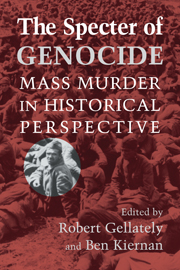Book contents
- Frontmatter
- Contents
- List of Contributors
- Acknowledgments
- INTRODUCTION
- PART I GENOCIDE AND MODERNITY
- PART II INDIGENOUS PEOPLES AND COLONIAL ISSUES
- PART III THE ERA OF THE TWO WORLD WARS
- PART IV GENOCIDE AND MASS MURDER SINCE 1945
- 13 “When the World Turned to Chaos”
- 14 Genocide in Cambodia and Ethiopia
- 15 Modern Genocide in Rwanda
- 16 History, Motive, Law, Intent
- 17 Analysis of a Mass Crime
- CONCLUSIONS
- Appendix: Convention on the Prevention and Punishment of the Crime of Genocide
- Index
14 - Genocide in Cambodia and Ethiopia
Published online by Cambridge University Press: 05 June 2012
- Frontmatter
- Contents
- List of Contributors
- Acknowledgments
- INTRODUCTION
- PART I GENOCIDE AND MODERNITY
- PART II INDIGENOUS PEOPLES AND COLONIAL ISSUES
- PART III THE ERA OF THE TWO WORLD WARS
- PART IV GENOCIDE AND MASS MURDER SINCE 1945
- 13 “When the World Turned to Chaos”
- 14 Genocide in Cambodia and Ethiopia
- 15 Modern Genocide in Rwanda
- 16 History, Motive, Law, Intent
- 17 Analysis of a Mass Crime
- CONCLUSIONS
- Appendix: Convention on the Prevention and Punishment of the Crime of Genocide
- Index
Summary
In his book, Revolution and Genocide (1992), political scientist Robert Melson pointed out that revolutionary states were the chief perpetrators of genocide in the twentieth century. He included Cambodia, Ethiopia, and Rwanda in his examples of genocides that occurred in the context of revolutions accompanied by war. But Melson is careful to note that not every revolution in the twentieth century led to genocide and not every genocide in the twentieth century was the consequence of revolution. In the 1970s Ethiopians and Cambodians thought that the revolutions that took place in their society would improve their economic conditions. Instead, the Ethiopian revolution claimed the lives of 1.2 million to 2 million people out of a prerevolutionary population of 45 million. That death toll was comparable to the 1.7 million to 2 million Cambodian lives lost during the Cambodian revolution. The estimated population of Cambodia before the revolution was 8 million. Some scholars, and other writers, have characterized these death tolls in the course of the two revolutions as genocide.
This chapter uses the comparative method to contribute to the debate on the relationship between revolution and genocide and the nature of the killing that took place during the Ethiopian and the Cambodian revolutions. The chapter argues that a case for genocide, as strictly defined in the UN Genocide Convention, can be established against the Cambodian Communist Party (a.k.a. the Khmer Rouge or the Angkar) from the overwhelming evidence of its selective and systematic annihilation of ethnic, racial, and religious groups.
- Type
- Chapter
- Information
- The Specter of GenocideMass Murder in Historical Perspective, pp. 307 - 324Publisher: Cambridge University PressPrint publication year: 2003



